Irfa’i
Environmental Health, Department of Health Polytechnic Banjarmasin, Ministry of Health, Indonesia
Correspondence to: Irfa’i, Environmental Health, Department of Health Polytechnic Banjarmasin, Ministry of Health, Indonesia.
| Email: |  |
Copyright © 2017 Scientific & Academic Publishing. All Rights Reserved.
This work is licensed under the Creative Commons Attribution International License (CC BY).
http://creativecommons.org/licenses/by/4.0/

Abstract
The main issue in the perspective expectation of tidal landfill is that it has great potential in polluting the environment. The volume of waste grows faster than the world population, and waste management is a very important issue for humans [1, 2]. One of the pollutants caused by Landfill is the formation of leachate. Leachate management can be done by way of reduction of organic waste through sorting on landfill. Leachate management of leach without intervention obtained effluen leachate processed processing Lindi Processing does not meet the quality standards. Modeling of leachate management without intervention resulted that the COD concentration effluent of Lindi Processing Installation from 2015 onwards exceeded quality standard of waste. Result of simulation of leachate management model with intervention of organic waste reduction at fraction of 40% got effluent COD concentration of Lindi Processing Installation fulfill requirement until year 2021, while at fraction of organic waste reduction 50% got COD concentration effluent Lindi Treatment Plant (LTP) fulfill requirement until modeling year (2025).
Keywords:
Model, Leachate Management, Organic Waste, Landfill
Cite this paper: Irfa’i, Leachate Management Model with Organic Waste Reduction Intervention in Tidal Waste Land: A Case Study in Landfill Basirih, Banjarmasin, Indonesia, Resources and Environment, Vol. 7 No. 5, 2017, pp. 131-137. doi: 10.5923/j.re.20170705.03.
1. Introduction
The resulting leachate from the landfill is an important source of environmental pollution around the landfill. Increased waste of Banjarmasin city reaches 1,019 m3 per day and tends to increase from year to year will increase leachate production and more potential to pollute the environment. The presence of leachate from the landfill has a high risk of contaminating water and soil around the landfill [3]. Lindi contains dissolved organic matter, inorganic and metallic compounds [4]. The presence of leachate has been identified as one of the major threats to water and soil resources [5].The quantity of leachate in the landfill is determined by the rain intensity, the effective area of the landfill, the evaporation, the infiltration / porosity of the soil and the moisture content of the waste. The quality of the leachate composition is determined by the type of waste, the amount of waste, the amount of water that dissolves the waste pile and the operational system. The purpose of this research is to know leachate management model to the surrounding environment. Leachate management approach model is done by reducing the organic waste material at the collection stage. Leachate management model is required in the effort of leachate management, including collection, distribution, processing and disposal of leachate into the environment.Leachate production derived from liquids in the trash due to the decomposition process, as well as the rain water is involved in the waste and the waste decomposition that accumulates in the bottom of the landfill and seeps through the soil [6]. Contamination occurs because continuous leachate permeates into the environment from time to time without any environmental consequences [7]. The amount and characteristics of leachate that is formed is also influenced by the amount of organic waste material. Some authors report that more than 190 substances are identified in leachate, so nearly 1% of the material is calculated from the total organic carbon concentration [8]. Around landfills in tidal areas further increase the potential for leach contamination from the environment. The existence of landfill leachate should be managed and processed so as not to cause environmental pollution. To perform the processing required accurate data, contamination patterns, quantity and quality of landfill leachate in tidal land.Leachate management model in the landfill is influenced by the amount of garbage entering terurama organic waste, the area of leachate collection, leachate storage duration, leachate distribution and the ability of leachate processing Installation. Leachate processing is also influenced by the quantity and quality of leachate, the type and stage of processing used in leachate processing. The effluent of leachate treatment must be in accordance with the quality standard of liquid waste that is allowed to be disposed in the environment.The presence of leachate in the landfill area is influenced by the direction of groundwater flow, the speed of groundwater, the porosity of the soil and the quality and quantity of pollutant leachate [9]. Surface water flows also have a role in landfill leachate distribution. Spreading through surface water flow is affected by inadequate landfill infrasctruture. Leachate protective leachate dikes result in leachate spread to. Leachate leach into the environment is not expected due to water runoff due to high rainfall intensity that can not be accommodated by Leachate treatment plant. This condition causes the leachate to spread to the environment. Tidal conditions also affect the pattern of pollutant spread.
2. Methods
The method used in this research is survey method. This survey was conducted to examine the physical aspects of the landfill as a place for garbage and leachate collection, quantity and quality of waste, quantity and quality of leachate, and the ability of leachate processing installation in leachate processing. Assumption modeling assumption is done with the following data approach (Table 1):Tabel 1. Formula/asumtion in Managemen Leachate Model with Removal Organic Waste Intervention
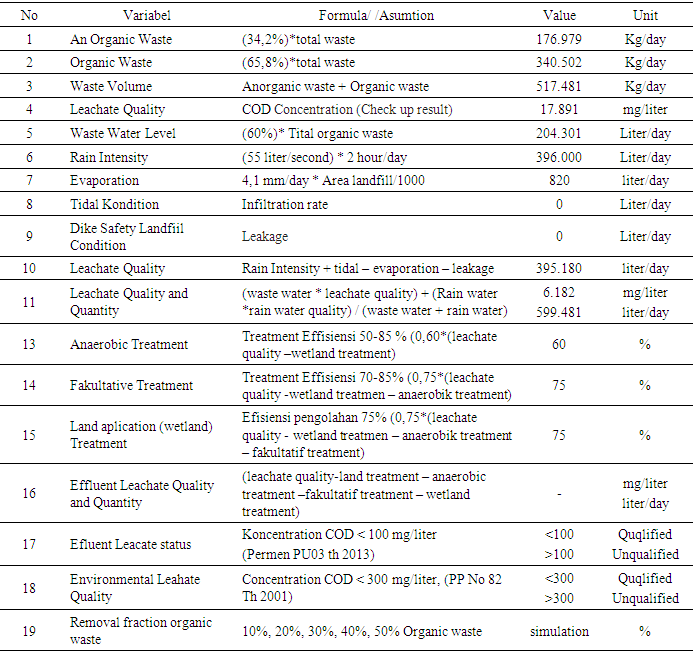 |
| |
|
The amount of waste that goes into landfill amounts is done for physical media to become a place for waste cultivation as well as the amount of waste and characteristic reviews. Surveys were also conducted on the conditions of landfill deposition especially the tides and the occurrence of subsidence of surface water, soil type, flood potential and rainfall intensity factor.Primary data obtained are: Measurement of garbage volume, garbage composition, density and garbage density and the quality of landfill leachate is done by sampling and leachate inspection. Leachate quality measurement is preceded by newly formed leaching and examination of leachate, leachate located in the anaerobic processing unit, leachate located in facultative processing unit, and leachate located in land treatment treatment unit (effluent LTP). The number of samples taken as many as 72 samples. Sampling of leachate quality is preceded by the manufacture of wells for water sampling. Determination of sample point is done linearly from source (landfill) with distance 0 meter, 50 meter, 100 meter, 150 meter and 200 meter towards tide and towards low tide. While the sampling of river water is done at the upstream flow point and at the downstream point in the river around the landfill. Water leachate pollutants in this study were Biological Oxygen Demand (BOD5), Chemical Oxygen Demand (COD), Total Disolved Solid (TDS), Iron (Fe) and NH3N. While the leachate pollutant parameters analyzed in soil in this research are P2O5, SO4, Iron (Fe) and N-HN4 soluble. Observations on the distribution of leachate pollutants were conducted over a year. Primary and secondary data are analyzed and formulated to state the quality of leachate in the environment around the landfill.Modeling is done by using powersim software (power simulation). Powersim is one of the most common models used to create and simulate dynamic system models and business model simulations. Simulation is defined as a behavioral replication of a phenomenon of symptoms or processes in the system. The simulation aims to describe the symptoms or processes and to generate analysis and forecasting of the interaction symptoms of the behavior of that element or process in the future [10].Before simulating a model, it is necessary to connect one variable to another, thus forming a system that can simulate the actual condition / system [10]. Variable variables will be described with some symbols, the main one is the "flow symbol" which is always associated with "level symbol". The powersim program works on building flow charts, causal diagrams, creating time graphs and time tables, which illustrates the behavior of models created.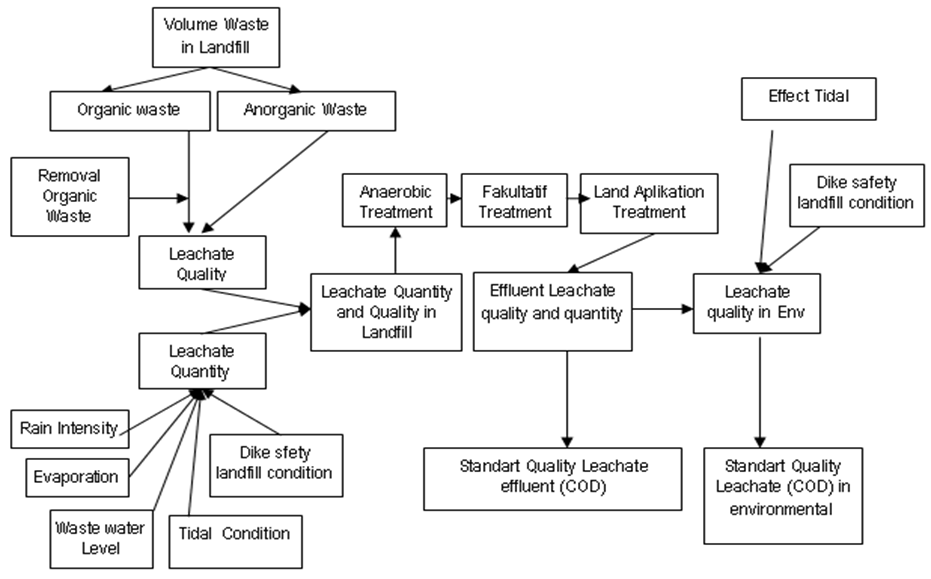 | Figure 1. The Circle Diagram of the Effect of Non-Interventional Model of Lindi Management |
In Figure 1, Trash consists of both organic and inorganic waste. The type and amount of waste will affect the quality and quantity of leachate. Increased waste generation will increase the amount of waste in the landfill. Increased waste in the landfill will increase the pollutant levels in the landfill including the increase in COD in leachate. Increasing the concentration of pollutants in leachate will complicate in leachate treatment at the Leachate Treatment Plant (LTP) in the landfill. If the processing capacity of LTP has limit of processing and the amount of waste always increases then LTP is not able to process leachate optimally and the LTP effluent is not in accordance with the effluent quality standard. By reducing the organic waste will reduce the pollutant (COD) in leachate, so the LTP load becomes light and the ability of landfill in treating leachate has a longer life.
3. Results and Discussion
3.1. Model of Management without Intervention
Increasing waste generation in Banjarmasin City will increase the amount of waste in the Basirih landfill. Increased waste in the landfill will increase pollutant levels in the landfill including increased COD in leachate. Increasing the concentration of pollutants in leachate will complicate in leachate treatment at the Leachate Treatment Plant (LTP) in the landfill. LTP processing capability has limit in processing, and also has limitation in processing waste amount. The amount of garbage is always increasing so the LTP is not able to process leachate optimally and the LTP effluent is not in accordance with the effluent quality standard. Inter action between the components in a system is a cause-effect diagram of an event or process. Between the components with each other interact and affect the performance of the system created [11]. Leachate management model without intervention is presented in Figure 1. Leachate management model without intervention meant no leach treating treatment in the processing other than the processing using existing LTP. Leachate management runs naturally without any outside intervention except LTP processing with the sequence of Anaerobic-Facultative-Wetland processes on the currently operated LTP.Based on the simulation of leachate management model without intervention at initial condition (year 2015) that is population growth 1,2% per year in population amounted to 674,440 people. The number of waste generation at Basirih landfill is 517.481 kg per day. The composition of organic waste amounted to 340.502 kg / day (65.8%). Based on laboratory results obtained COD levels in leachate of 17.891 mg / liter. After leachate mixed with rain water, the concentration of COD on leachate is 6,182 mg / liter. Further leachate is carried out by way of treating leachate in LTP. The effluent issued by LTP Basirih landfill exceeds the specified quality standard, ie COD <100 mg per liter [12]. Assessment was also performed on leachate quality in the environment around the landfill with a quality standard for COD of <300 mg per gram [13]. The following is the result of leach modeling simulation without intervention.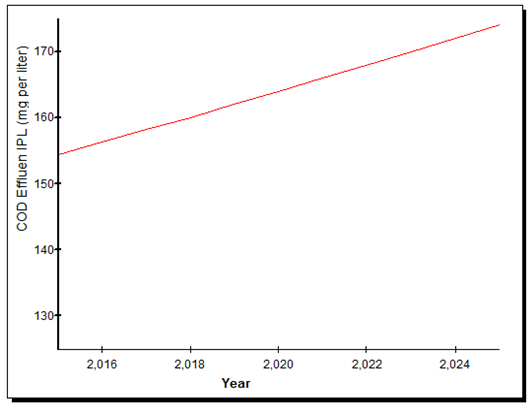 | Figure 2. Graph of COD Content in the Leprosy Management Model Without Intervention |
Based on the simulation result, leachate management model without intervention (figure 2) obtained leaching effluent from LTP processing that discharged to the environment around Basirih Landfill did not meet the standard requirement (standart 100 mg / l). In the graph above, the concentration of COD in 2015 amounted to 154.57 mg / liter. Based on the quality standard of water quality in the environment, COD concentration still meets the environmental quality standard requirement (standart 300 mg / l). The projected COD concentration of LTP effluent in the next year is increasing along with the increase of population and waste generation at Basirih Landfill. To see the simulation results can be seen in Table 2 as follows:Table 2. COD levels in the Leprosy Management Model Without Intervention
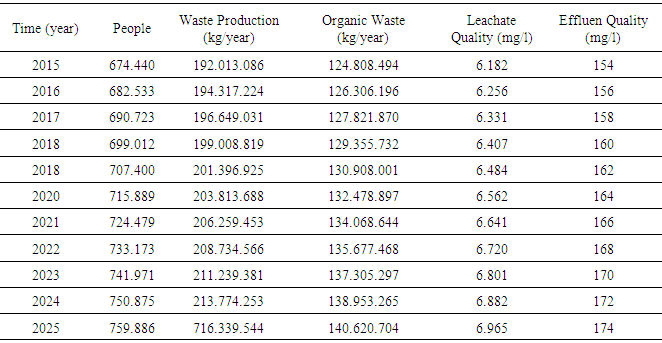 |
| |
|
Based on table 2 above, the projection of leachate management model without intervention is obtained as follows: COD concentration of LTP effluent from 2015 until 2025 exceeds quality standard of waste. In the table is indicated by the results > 100 mg / l in the Effluent Quality column, but for the environmental quality standard environment still meets the environmental quality standard marked with <300 mg / l.Leachate management model without intervention in landfill can be explained in the mathematical equation as follows: | (1) |
 | (2) |
 | (3) |
 | (4) |
 | (5) |
Note:KKL (t + dt) : Health Change Environment unity of time (COD mg / liter).KKL (t) : Environmental Health Change at t (COD mg / liter).KCODlandfill : COD concentration of mixed leachate in landfill (mg / liter)JAS : Amount of waste water leachate (liters).KCODS : COD content in waste leachate (mg / liter).JAP : The amount of mixing water (liter).KCODAP : COD content of mixing water (mg / liter).KAs : Waste water content (%).JSO : The amount of organic waste (kg).Ah : The rain water discharge (liter / sec).Aps : The amount of water entering landfill due to ups and downs (liter).P : Evaporation (mm / day). Area of landfill / 1000 (liter / day).Kb : The amount of water due to leakage of embankments (liters).RCODLTP : Removal of COD LTP (mg / liter).KCODLC : COD content of leachate mixture. (mg / liter).EfAn : Efficiency of anaerobic treatment (%).EfFak : Efficiency of facultative processing (%).EfWL : Efficiency of wetland processing (%).The results of this simulation illustrates that the ability of LTP Basirih landfill still not able to treat leachate well. Leachate management has not been carried out continuously on aspects of the waste process from the beginning to the end of the process. There has not been any sorting of organic waste for composting nor the optimal operation of LTP.
3.2. Model of Management of Lindi with Organic Waste Reduction Intervention
Leachate management model with organic waste reduction intervention is intended to reduce organic waste. Reduction of organic materials through sorting activities for composting etc to organic waste. Reduction of organic waste through composting activities will reduce the levels of COD in waste leachate. The modeling simulation is done in the form of percentage of organic waste processed to make compost in Basirih landfill. Composting activity has an effect on to pollutant concentration in leachate. With the composting activity will reduce the burden of pollutants to be processed through LTP in Basirih landfill. Leachate management is done in the order of Anaerobic-Facultative-Wetland process on the currently operated LTP. Leachate management model with organic waste reduction interventions is presented in Figure 1.Model simulations with organic waste reduction interventions were performed at fractions of 10%, 20%, 30%, 40% and 50%. Based on simulation results of leachate management model with organic waste reduction interventions show as follows: For fraction of 10%, 20% and 30% obtained COD concentration of LTP effluent exceed standard waste effluent quality standard. For the fraction of 40%, the COD concentration of LTP effluent fulfilled the requirement until 2021, while for the fraction of 50% organic waste found the COD concentration of LTP effluent fulfill the requirement until modeling year (2025). Standard quality standard based on LTP effluent quality standard [12] To see the trend of increasing the COD concentration COD of LTP effluent can be seen in the following figure 3.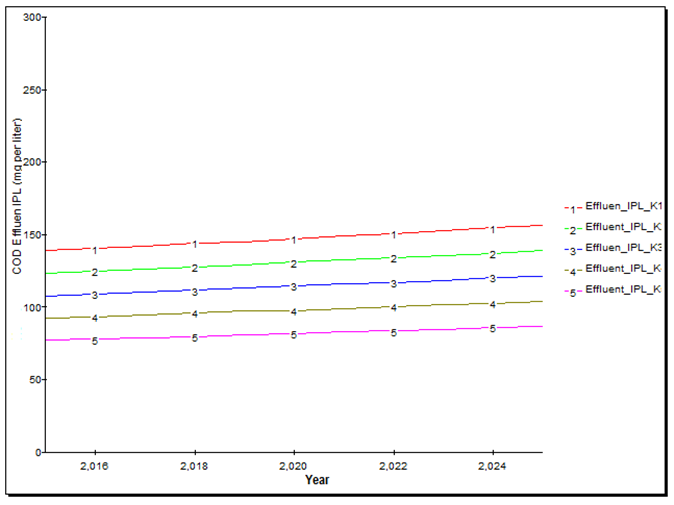 | Figure 3. Graph of COD Content in the Lindi Management Model with Organic WasteReduction Intervention |
Based on simulation results of leachate management model with 10%, 20% and 30% organic waste reduction interventions (figure 3), effluent of LTP processed leaching into the environment around Basirih Landfill did not meet the standard requirement (standart100 mg / l). As seen in the graph above, the COD concentration in 2015 exceeds 100 mg / liter. The simulation results of leachate modeling model with 40% and 50% organic waste reduction interventions found that LTP leachate effluent discharged into the environment meet the standard requirements (standard 100 mg / l). Based on the quality standard of water quality in the vicinity of the Basirih Landfill, the COD concentration still meets the environmental quality standard requirements (standard 300 mg / l). The projected COD concentration of LTP effluent in the next year is increasing along with the increase of population and waste generation at Basirih Landfill. To see the simulation results can be seen in Table 3 as follows:Table 3. COD content of the Lindi Management Model with Interventions of organic waste reduction 10%, 20% and 30%
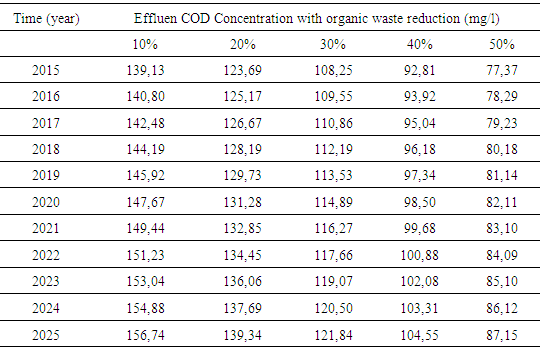 |
| |
|
The simulation results of leachate modeling model with organic waste reduction intervention can be explained as follows: Simulation of reduction of organic waste 10% yields COD effluent value of LTP of 139.13 mg / l in 2015 to 156,75 mg / l in 2025. Simulation of waste reduction organic 20% yields COD levels of effluent LTP of 123.69 mg / l in 2015 to 139.34 mg / l in 2025. Simulation of 30% organic waste reduction resulted in COD effluent of LTP of 108.25 mg / l in 2015 to 121.94 mg / l by 2025. Simulation of 40% organic waste reduction resulted in COD effluent of LTP of 92.81 mg / l in 2015 to 104.55 mg / l in 2025. Simulation of 50% organic waste reduction resulted COD levels of LTP effluent of 77.37 mg / l in 2015 to 87.15 mg / l in 2025.Leachate management model with organic waste reduction interventions at Banjarmasin Landfill can be described in the mathematical equation as follows: | (6) |
 | (7) |
 | (8) |
 | (10) |
Note:MPA (t + dt): Health Environment unity of time (COD mg / liter).KKL (t) : Environmental Health at t (COD mg / liter).KIPSOCODlandfill: COD concentration of mixed leachate in landfill (mg / liter)JAS : Amount of waste water leachate (liters).KIPSOCODS: COD content Intervention reduction of organic waste (mg / liter).JAP : The amount of mixing water (liter).KCODAP : COD content of mixing water (mg / liter).KAs : Waste water content (%).JSO : The amount of organic waste (kg).Ah : The rain water discharge (lliter / sec).Aps : The amount of water entering landfill due to ups and downs (liter).P : Evaporation (mm / day). Area of landfill / 1000 (liter / day).Kb : The amount of water due to leakage of embankments (liters).RCODLTP : Removal COD LTP (mg / liter).EfAn : Efficiency of anaerobic treatment (%).EfFak : Efficiency of facultative processing (%).EfWL : Efficiency of wetland processing (%).The results of this simulation are: 40% organic waste reduction interventions produce effluent COD levels that meet quality standard requirements until 2021. For simulation 50% organic waste reduction results in effluent COD levels that meet the quality standard requirements until the final year of modeling (2025). While for environmental quality, organic material reduction intervention has result of COD LTP Effluent comply with environmental quality standard.The reduction of organic waste in leachate management process does not necessarily decrease COD effluent level at the moment. Decreased COD effluent can occur after a number of organic matter undergoes a decomposition process until it becomes a simple organic material. The formation of leachate with the content of pollutants is the accumulation of waste decomposition process from time to time in the landfill. The process of decomposition of organic matter takes between 60 s / d 90 days [14]. Recycling and recovery of materials and energy are encouraged to protect natural resources and avoid wasteful land use [8]. To improve leachate efficiency, it can add a land aplication processing unit at the end of the process [14].
4. Conclusions and Suggestion
4.1. Conclusions
Leachate management of leachate without intervention resulted leaching effluent of processed LTP discharged into the environment does not meet the standard requirements (standart <100 mg / l). As seen in the graph above, the concentration of COD in 2015 is 154.57 mg / liter. The results of modeling on leachate management with 10%, 20% and 30% organic waste reduction interventions (figure 3) obtained leaching effluent of processed LTP discharged into the environment, not meeting the standard requirements (standard <100 mg/l). The simulation results of leachate modeling model with Intervention on 40% and 50% organic waste reduction found that LTP leachate effluent discharged into the environment meet the standard requirements of effluent LTP (standard <100 mg / l) until 2025. But if we see leachate quality based on quality standard water quality in the environment, the concentration of COD still meets the requirements of environmental quality standard (standart <300 mg / l).
4.2. Suggestion
Reducing organic waste prior to disposal to landfill or reducing organic waste prior to landfilling in the landfill needs to be done to reduce leachate treatment load. For further research, it is necessary to investigate the effectiveness of organic waste reduction in various ways so that the optimal organic waste reduction formula can be found.
Thank You Note
Thanks to Mr. Prof Suyadiand Mr. DR Bagyo Yanuwiadi as a Promoter dan Co-promoter. We also present a thank you for the Director of Poltekkes because of the funding support in the implementation of learning assignment as well as the other parties which we can not mentioned one by one.
References
| [1] | Salem Z, Hamouri K, Djemaa R, Allia K., 2008. Evaluation of landfill leachate pollution and treatment. Desalination.; 220(1–3): 108–114. |
| [2] | Renou S, Givaudan JG, Poulain S, Dirassouyan F, Moulin P, 2008. Landfill leachate treatment: Review and opportunity. Journal of Hazardous Materials.; 150(3): 468–493. |
| [3] | Ikem A., O. Osibanjo, M.K.C. Sridhar, and A. Sobande, 2002., ‘Evaluation of Groundwater Quality Characteristics near Two waste Sites in Ibadan and Lagos, Nigeria’, Journal Water, Air, and Soil Poll, 2002, 140: 307–333. Kluwer Academic Publishers, the Netherlands. |
| [4] | Christensen, T.H., P. Kjeldsen, P.L. Bjerg, D.L. Jensen and J.B. Christensen et al., 2001. Biogeochemistry of landfill leachate plumes. Applied Geochem., 16: 659-718. |
| [5] | USEPA, 1984. A ground water protection strategy for the environmental protection agency. United States Environmental Protection Agency (USEPA), Office of Ground-Water Protection, Washington, DC., USA., August 1984. |
| [6] | Mor, S., K. Ravindra, R.P. Dahiya and A. Chandra, 2006. Leachate characterization and assessment of groundwater pollution near municipal solid waste landfill site. Environ. Monit. Assess., 118: 435-456. |
| [7] | Longe, E.O. and M.R. Balogun, 2010. Groundwater quality assessment near a municipal landfill, Lagos, Nigeria. Res. J. Applied Sci. Eng. Technol., 2: 39-44. |
| [8] | EEC., 1999. Council Directive on the landfill of waste. 99/31/EEC. |
| [9] | Damanhuri, E. Sian. P Padmi. T, 2010. Waste Management: Handbook Lecture TL-3104, - Programs Environmental Engineering, Faculty of Civil and Environmental Engineering, Bandung Institute of Technology. |
| [10] | Muhammadi, E., Aminullah and B. Soesilo. 2001. Dynamic Systems Analysis: Environment, Social Economics, Management. UMP Press, Jakarta. Forrester, J. W. 2007b. System Dynamics - The Next Fifty Years. System Dynamics Review 23 (2-3): 359-370. |
| [11] | Regulation of the Minister of Public Works No. 03 of 2013 on Quality Standard of Liquid Waste of Landfill. |
| [12] | Government Regulation No. 82/2001 on Water Quality Management. |
| [13] | Tchobanoglous G, Theisen H, & Vigil S. 1993. Integrated Solid Waste Management, Engineering PrincWWTes and Management Issues. New York: McGraw-Hill, Inc. pp. 381-417. |
| [14] | Hermana. Joni, 2007. Alternative Potential of Leachate Processing Chemically. Workshop Inovase Waste Processing Technology Directorate of PLP Development, Directorate General of Human Settlements, State Minister of Public Works and Public Housing. |















 Abstract
Abstract Reference
Reference Full-Text PDF
Full-Text PDF Full-text HTML
Full-text HTML

